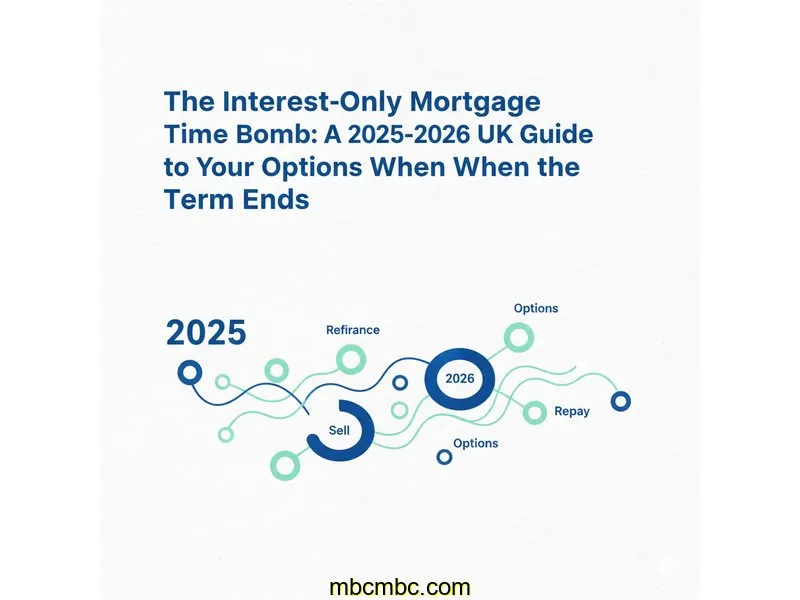
Picture this: a letter lands on your doormat from your mortgage lender. It's the one you’ve likely been anticipating, perhaps with a growing sense of unease. Your 15-year interest-only mortgage matures in 12 months, and the £175,000 capital balance is due in one single payment. Your original repayment plan—perhaps an endowment policy that underperformed or an investment ISA you had to dip into—is no longer sufficient. You're staring at a significant financial shortfall.
If this scenario feels familiar, you are far from alone. This is the "interest-only time bomb" that regulators and lenders have been tracking for years. According to the Financial Conduct Authority (FCA), there were still 751,000 pure interest-only homeowner mortgages outstanding at the end of 2023. Of these, thousands are set to mature each year, with 46,000 (around 6%) maturing by the end of 2025 (FCA, 2024). The core problem is that many borrowers, often approaching retirement, do not have a credible plan to repay the capital lump sum. Let's explore your practical options.
Key Takeaways
- The Core Problem: An interest-only mortgage pays just the interest. At the end of the term, you must repay the entire original loan amount in one go.
- You Are Not Alone: Over 750,000 UK homeowners still have interest-only mortgages, with thousands maturing each year, many with a repayment shortfall.
- Act Early: Your options become severely limited if you wait until the maturity date. Lenders are more flexible with borrowers who engage 12-24 months in advance.
- Key Options Include: Selling your home, remortgaging (often to a repayment plan), using equity release, or negotiating a new plan with your current lender.
- Disclaimer: This article provides informational guidance on common pathways. It is not financial advice. Your situation is unique, and the implications (especially for tax, inheritance, and benefits) are complex. You must seek regulated financial advice from a qualified mortgage broker or financial advisor.
How Did We Get Here? The "Repayment Vehicle" Explained
In the 1990s and early 2000s, interest-only mortgages were common. The monthly payments were low, making properties seem more affordable. The assumption was that you would also pay into a separate savings plan—the "repayment vehicle"—which would grow over time to clear the debt at the end. Common vehicles included endowment policies, ISAs, or other stock market investments.
To understand the difference, let's use an analogy. Think of a repayment mortgage like buying a car on a standard finance plan: every monthly payment buys you a little more of the car, and at the end of the term, you own it outright. An interest-only mortgage is like leasing the car for 25 years. You pay a monthly fee just to use it, but at the end of the lease, the finance company demands the car's full original price in one lump sum. The "repayment vehicle" was the savings pot you were *supposed* to be building to buy the car at the end. The "time bomb" is reaching the end of the lease with an empty savings pot.
The 2008 financial crisis, followed by stricter lending rules, largely put an end to this practice for residential buyers. However, the legacy of those original loans remains. Lenders are now proactively contacting borrowers, with UK Finance reporting that 92% of interest-only mortgage customers whose terms end by 2030 have been contacted by their lender to discuss their plans (UK Finance, 2023). "Doing nothing" is not an option and will ultimately lead to repossession.
A Comparison of Your 5 Main Options When the Term Ends
When you're facing a maturity date with a shortfall, your options narrow to five main pathways. Each has significant pros and cons, and the "right" one depends entirely on your age, income, property value, and retirement plans. The table below provides a high-level comparison.
| Option | How It Works | Key Advantage | Key Disadvantage | Who Is It For? |
|---|---|---|---|---|
| 1. Repay in Full | Use existing savings, investments, inheritance, or pension lump sum (with caution) to pay the capital balance. | You become mortgage-free instantly. Total peace of mind. | Most people in this situation don't have the cash. Can deplete retirement savings. | Borrowers with sufficient cash savings, large maturing investments, or a planned inheritance. |
| 2. Sell Your Home | Sell the property on the open market. Repay the mortgage from the proceeds and (hopefully) keep the remaining equity. | A "clean break." Frees up all your equity. Allows you to downsize to a more manageable, mortgage-free home. | You have to leave your home. High emotional and financial costs (agent fees, Stamp Duty on new purchase). | Borrowers with significant equity who are willing to downsize or move to a cheaper area. |
| 3. Remortgage | Find a new lender willing to offer you a new mortgage. This will almost certainly be on a (more expensive) capital repayment basis. | You get to stay in your home. You pay off the debt over a new, structured term. | You must pass very strict affordability tests, which is difficult if you're retired or have a low income. | Borrowers who are still working, have a high-value property (low LTV), and a provable income. |
| 4. Equity Release | A "lifetime mortgage" for over-55s. A loan is secured against your home, which is repaid (with rolled-up interest) when you die or go into care. | You stay in your home, make no monthly payments, and receive a lump sum to pay your old lender. | Interest "rolls up" and grows quickly, significantly reducing the inheritance you leave. | Older borrowers (typically 60+) who have significant equity and want to stay in their home above all else. |
| 5. Negotiate with Lender | Speak to your existing lender to agree a new plan. This could be a term extension or a "part-and-part" mortgage. | Potentially more flexible than a new lender, as they want to avoid repossession. | Not a permanent solution. An extension just delays the problem unless you also switch to repayment. | Borrowers who act early and can prove a new, credible plan (e.g., "I will retire in 3 years and repay from my pension lump sum"). |
A Deeper Dive: The Reality of Equity Release and Remortgaging

For most people, the choice boils down to selling, remortgaging, or equity release. Let's look at the two options that allow you to stay in your home.
The Hurdles of Remortgaging in Retirement
If you're 58 and your interest-only term is ending, finding a new lender to offer you a 15-year repayment mortgage can be tough. Lenders must apply strict "affordability" tests. They will assess your current income, and if you plan to retire during the new term, they must assess your ability to pay based on your projected pension income. For many, this is an insurmountable hurdle. Lenders may also have maximum age limits, refusing to lend past your 70th or 75th birthday.
Equity Release: The Popular (but Costly) Solution
Given the difficulties of remortgaging, many are turning to equity release (specifically, a lifetime mortgage). This is a loan secured on your home, but you make no monthly payments. Instead, the interest is added to the loan, "rolling up" and compounding over time. The entire balance is repaid from the sale of your home when you die or move into long-term care.
This path is becoming increasingly common. The Equity Release Council (ERC) reported that in Q1 2024, customers accessed over £600 million in property wealth (ERC, 2024), with many using it to clear outstanding mortgages. The major advantage is that you get to stay in your home, mortgage-free. The major disadvantage is the cost: a £100,000 loan at 6% interest could grow to £320,000 over 20 years, significantly impacting any inheritance. Regulated equity release products now come with a "no negative equity guarantee," meaning your estate will never owe more than the property's value.
Common Questions About the Interest-Only Maturity Crisis
Based on questions I've seen across financial forums, here are some of the most common points of confusion.
What is a 'repayment vehicle' and what happens if mine failed?
A "repayment vehicle" was the separate savings or investment plan you were supposed to pay into to grow a lump sum. The most common was an endowment policy. Many of these policies "failed" (or "underperformed") in the 2000s, meaning they didn't grow as much as projected, leaving a shortfall. If your vehicle has failed, you are in the same position as someone who never had one: you are responsible for finding the cash to repay the capital.
Can I still get an interest-only mortgage for my main home?
It is very difficult, but not impossible. Lenders will typically only offer residential interest-only mortgages to "high net worth" individuals who have a very high income (e.g., £100k+) and/or significant other assets. You will also have to prove you have a separate, credible repayment plan in place from day one. For the vast majority of standard borrowers, this option is no longer available. Interest-only is, however, still the standard model for buy-to-let mortgages.
My lender offered a 'term extension'. Is this just delaying the problem?
Yes and no. A "term extension" (e.g., giving you another 2-5 years) can be a valuable lifeline, *if* you use that time to enact a real plan. For example, it could give you time to sell your house without a fire-sale panic. Or, if you're 63, it might extend the term until you're 67, at which point you *can* access your pension lump sum to repay the debt. However, if you simply accept the extension and continue to make no progress on a repayment plan, you are just delaying the inevitable and will be in the exact same position in a few years.
Conclusion: Your Next Steps
Facing an interest-only mortgage shortfall is one of the most stressful financial events a homeowner can experience. But the key takeaway is that you have options, *especially* if you act early. Burying your head in the sand is the one action that guarantees the worst possible outcome.
Start by calculating your exact shortfall. Then, review the options in the table above and consider which are realistic for you. Is selling and downsizing a possibility? Or are you determined to stay in your home, making equity release a more likely path? Once you have a clearer idea, your next call should be to a regulated financial advisor or a specialist mortgage broker. They can provide a full, confidential review of your finances and guide you through the pros and cons of each pathway, ensuring you make an informed decision rather than a panicked one.

